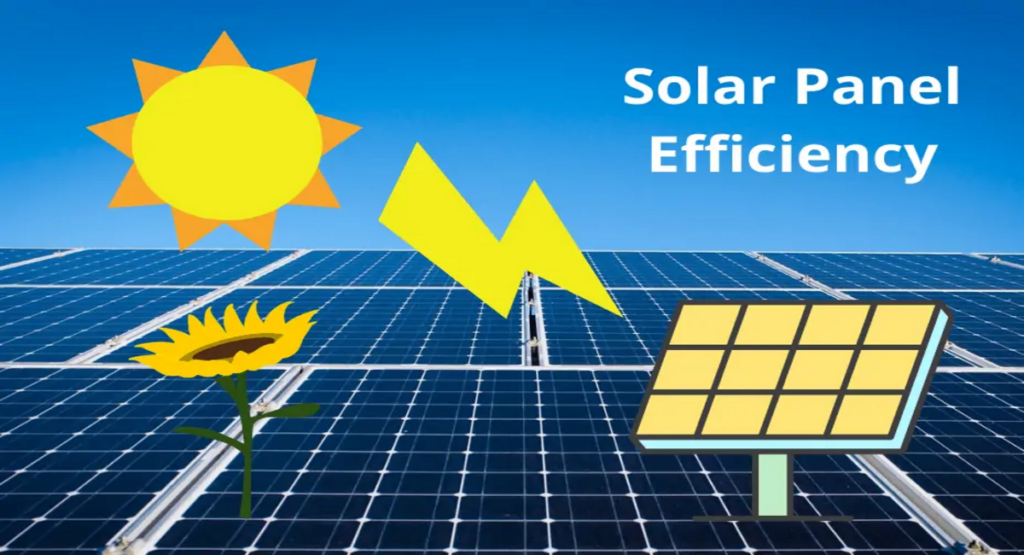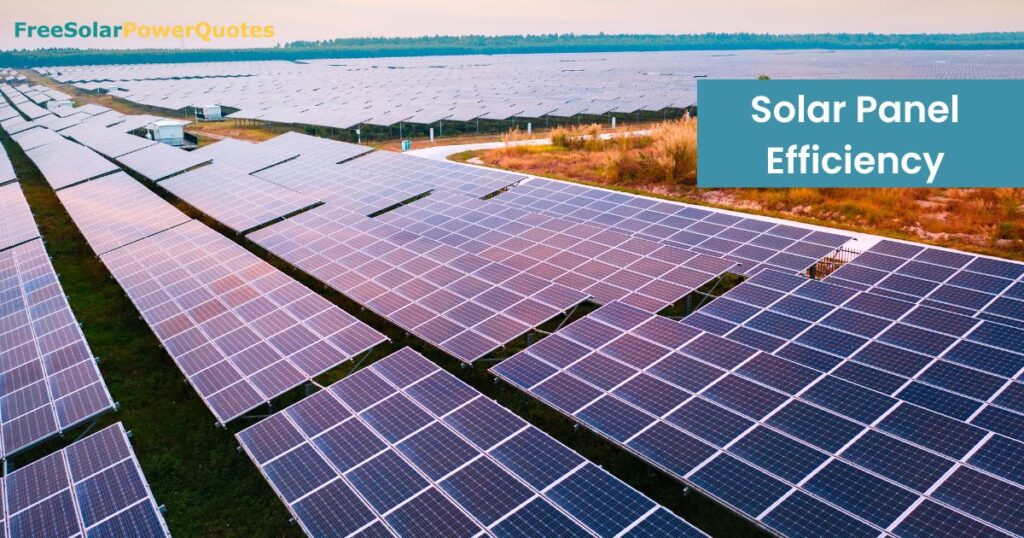Solar panel efficiency is its ability to convert sunshine into power. This efficiency is expressed as a percentage and indicates how effectively a solar panel can harness the energy from the sun. The conversion of sunlight into electricity is a crucial step in harnessing renewable energy, and it is essential to understand the factors that affect solar panel efficiency.
What is Solar Panel Efficiency?
Solar panel efficiency measures how much sunlight a solar panel can convert into usable electricity. It’s the ratio of how much electricity a solar panel produces to how much energy the sun gives. The efficiency of a solar panel can range from as low as 10% to as high as 24%. The average efficiency of solar panels today is around 15-20%.
Factors Affecting Solar Panel Efficiency
Cell Structure
The structure of the photovoltaic cells within a solar panel is a crucial factor in determining its efficiency. Currently, monocrystalline and polycrystalline cells are the most common types of cells used in solar panels. The efficiency and durability of monocrystalline cells are well-established facts. On the other hand, polycrystalline cells are made up of multiple crystal structures and have a slightly lower efficiency than monocrystalline cells.
Cell Size and Temperature
The size of the photovoltaic cells within a solar panel can also affect its efficiency. Larger cells can capture more sunlight and convert it into usable electricity, leading to higher efficiency. Additionally, high temperatures can reduce the efficiency of solar panels. To combat this, many solar panels today come equipped with cooling systems that dissipate heat and keep the panels functioning optimally.
Angle and Orientation
The angle at which a solar panel is installed can greatly affect its efficiency. The optimal installation angle for solar panels is 90 degrees, plus the area’s latitude. This will ensure that the panels receive maximum sunlight exposure throughout the day. Additionally, the orientation of a solar panel is also important. Solar panels facing directly towards the sun will have higher efficiency than those facing away.
Environmental Factors
Environmental factors such as dust, debris, and shading can greatly reduce the efficiency of a solar panel. Dust and debris can accumulate on the panel’s surface, reducing the amount of sunlight that can penetrate through. Similarly, shading from nearby trees or buildings can also reduce the efficiency of a solar panel. Cleaning and maintaining solar panels regularly is essential for optimal performance.
Improving Solar Panel Efficiency
Advanced Cell Structures
Developing advanced cell structures, such as multi-junction cells, has significantly improved solar panel efficiency. Multi-junction cells are composed of multiple layers of photovoltaic materials, each with a different bandgap. This allows for the absorption of a wider range of the sun’s spectrum, leading to higher efficiency.
Increased Cell Size
As mentioned earlier, the size of the photovoltaic cells within a solar panel can greatly affect its efficiency. Increasing the size of these cells makes it possible to capture more sunlight and convert it into usable electricity, leading to higher efficiency.
Improved Cooling Systems
High temperatures can greatly reduce the efficiency of solar panels. By incorporating advanced cooling systems into solar panels, it is possible to dissipate heat and keep the panels functioning at optimal efficiency.
Optimized Installation
Installing solar panels at the right angle and orientation can significantly improve their efficiency. Using tools such as sun trackers can ensure that solar panels always face directly toward the sun and receive maximum sunlight exposure.

The Future of Solar Panel Efficiency
The future of solar panel efficiency is promising, with many advancements and improvements in the field. Here are a few key areas in which we can expect to see advancements in the future:
- Improved Cell Structures: The development of advanced cell structures, such as multi-junction cells, has already led to significant improvements in solar panel efficiency. As research and development in this area continue, we will likely see even more efficient cell structures in the future.
- Increased Cell Size: As cell size is directly proportional to the amount of sunlight that can be captured, we will likely continue to see an increase in cell size in the future. This will lead to higher efficiency and more renewable energy being harnessed from the sun.
- Integration with Other Technologies: As the demand for renewable energy continues to grow, we will likely see an increased focus on integrating solar panels with other technologies, such as energy storage systems and smart grid technologies. This will allow for more efficient and effective use of renewable energy and will lead to higher overall efficiency.
- Improved Manufacturing Processes: As the demand for solar panels continues to grow, it is likely that we will see improvements in the manufacturing processes used to produce them. This will result in higher quality and more efficient solar panels, improving overall efficiency.
- Increased Government Support: Governments worldwide are showing an increased interest in promoting the use of renewable energy. Increased financing for research and development into improving the efficiency of solar panels is a possible outcome of this.
Overall, the future of solar panel efficiency is very promising, with many exciting advancements and improvements on the horizon. As demand for renewable energy grows, investment and progress in this sector will certainly increase the efficiency and utilization of this plentiful clean energy.
Bottom Line
The efficiency of solar panels is a key part of getting clean energy from the sun. A range of factors, including cell structure, size and temperature, angle and orientation, and environmental factors, determines a solar panel’s efficiency. By understanding these factors and implementing solutions such as advanced cell structures, increased cell size, improved cooling systems, and optimized installation, it is possible to improve the efficiency of solar panels and harness more renewable energy from the sun. Increasing solar panel efficiency and capitalizing on this plentiful clean energy source is crucial as the demand for renewable power sources rises.
Get your free solar power quote today by contacting us at freesolarpowerquotes.com! Don’t wait any longer to start harnessing the power of the sun.
FAQS
What are high-efficiency solar panels?
High-efficiency solar panels are solar panels that have a higher capacity to convert sunlight into electricity compared to traditional solar panels. They are designed to capture more sunlight and convert it into usable energy, leading to higher energy output and greater cost savings.
What makes high-efficiency solar panels better?
High-efficiency solar panels convert more sunshine into energy, resulting in better energy output and cost savings. They are also smaller, making them better for tight installations.
How do high-efficiency solar panels work?
Advanced cell architectures and materials improve solar panel efficiency. They also often use more efficient cooling systems and other technologies that improve their overall efficiency.
What are the benefits of using high-efficiency solar panels?
High-efficiency solar panels’ benefits include higher energy output, greater cost savings, improved energy independence, and a reduced carbon footprint. They are also often more suitable for installations where space is limited.
Where can I find high-efficiency solar panels?
High-efficiency solar panels can be found through solar panel manufacturers, distributors, and solar installation companies. You can also research and compare different products online to find the best options for your needs.
How efficient are solar panels?
Solar panels are typically between 15-20% efficient, meaning that they can convert 15-20% of the sunlight they receive into electricity.
What are the most efficient solar panels?
Currently, monocrystalline and polycrystalline solar panels are considered to be among the most efficient, with efficiencies of around 20%. Thin-film solar panels typically have lower efficiencies, around 15%.
What is the most efficient solar panel?
The most efficient solar panel can vary depending on the technology used and the specific model. However, monocrystalline and polycrystalline solar panels tend to have some of the highest efficiencies, with some models reaching over 22%.
Are solar panels efficient?
Solar panels are considered to be relatively efficient, with an average efficiency of 15-20%. This means that they can convert 15-20% of the sunlight they receive into electricity.
Do solar panels work on cloudy days?
Solar panels can still produce some electricity on cloudy days, although their output will be lower than on sunny days. On cloudy days, the output of solar panels is proportional to the density of the overcast sky. Still, it is typically only a fraction of what is produced on sunny days.

